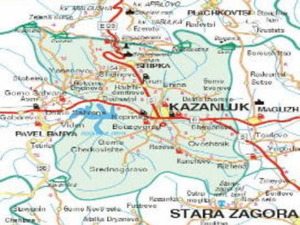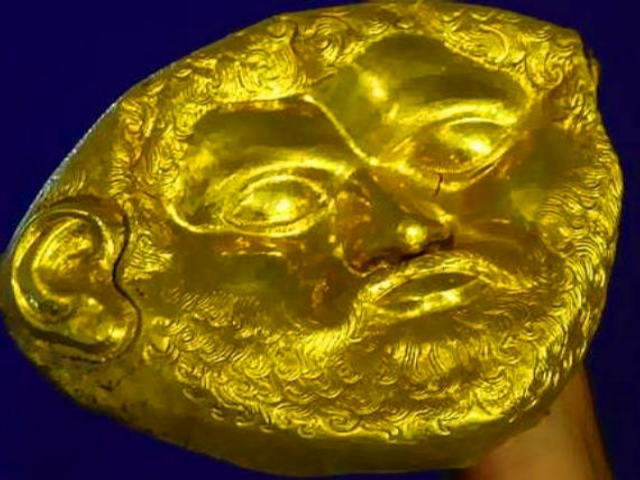KAZANLAK
The town of Kazanlak is located in the pretty Valley of Roses at the foot of the Balkan mountains. Kazanlak is located 200 km east of Sofia and 108 km northeast of Plovdiv. The natural geographical centre of Bulgaria is just here where the roads of home and international tourist routes cross each other. In this area the nature has combined the beauty and majesty of the Balkan mountains with the fertility of the Tundzha river valley.
The hot mineral springs of the region (located in the town of Pavel Banya and in the villages of Ovoshtnik and Yagoda) make the region more attractive for many tourists from home and abroad.
The oil-yielding rose – Rosa Damascena – was brought to Bulgaria from India via Persia, Syria and Turkey.
Rose picking last for about a month – from May 20 to June 20, but that depends on the spring weather conditions. Picking is done every morning from 5 till 9-10 o’clock. The basic technology of the production of the famous Bulgarian rose oil is double distillation. Bulgarian rose oil has the highest quality worldwide – it has no competition.
A large collection of objects, photos and documents traces the 330 year old history of Bulgarian rose industry. Among the exhibits are some original pieces of equipment: stills for distilling the rose oil; instruments for separating the oil from the rose water; bottles, containers and craters for storing and exporting the oil; logos of rose traders, photographs and documents of rose traders families, etc.
Visitors can purchase rose, mint and lavender essential oils; various rose products, rose liqueur, rose brandy, and souvenirs from the daily life of rose producers.
Each first Saturday and Sunday of June Kazanlak organizes the traditional Celebration of the Rose, an unforgettable experience of Bulgarian beauty, merriment and hospitality.
In 1944 the THRACIAN TOMB, world-famous for its murals was unearthed by chance during the construction of an air defence observation post. It is on UNESCO's World Heritage list. This is the only place in Bulgaria where completely preserved painting - a masterpiece of early Hellenistic art can be seen. The Thracian Tomb is located in the north part of Tyulbeto Park and dates to the end of the 4-th or early 3-rd century). The spatial design of the Kazanluk Tomb, and in particular, the careful execution of the two brickwork chambers - the corridor and the burial chamber - indicate that the builders had considerable knowledge of the art of building. The murals are the chief asset of the Kazanluk Tomb, because they are the only entirely preserved work of Hellenistic art that has been found in exactly the state in which it was originally designed and executed. The murals decorating the corridor and the burial chamber are of unique perfection. The unknown artist has painted with simple devices one of the most complex decorative systems, achieving an impact that is not to be found either earlier or later in Hellenistic art. The murals are the reason for the exceptional interest that the Tomb has provoked in numerous Bulgarian and foreign scholars. The composition in the burial chamber is designed with great skill and knowledge of the architectural elements of the Ionic entablature. The painter, however, has intentionally infringed the Ionic proportions with the large figure frieze. He thus achieved an exceptional impact by enclosing the entire composition in a colourful frame of architectural motifs. The art of the unknown painter of the Kazanluk Tomb is very original. The various elements of the composition are executed with an originality that differs from the well-known examples in antique Greek art. The subject of the frieze in the burial chamber is again a popular element of Greek sepulcher art.
The composition, however, is saturated with figures which further elaborate the subject and illustrate in detail the way of life and customs of Thracian aristocracy.
The Kazanluk Tomb is a peak in the development of Hellenistic art. It is a significant contribution to the art of the entire Hellenistic world. The Tomb is an irrefutable proof of the high material and intellectual culture of the ancient Thracians, which were to be inherited by the Bulgarian nation later on. The Thracian Tomb at Kasanluk was included in the list of monuments of world importance in 1979 because it is an exceptional achievement of human genius and a valuable testimony to an ancient civilization.
Recently ten more Thracian tombs-mausoleums have been unearthed near Kazanlak. Some of them are of great importance - Ostrousha - 2km south of Shipka, Golyama Arsenalka - near the village of Sheinovo, and the tombs of Shoushmanets necropolis near the town of Shipka - Helvetia, the Griffins, and the Tomb with the Columns. Thracian rulers and members of the nobility were buried in monumental stone tombs, which also served as places for ritual ceremonies to honor the deceased ruler, with offerings of rich funeral gifts.
THE KOSMATKA TOMB, KAZANLAK. In the summer of 2004 a team of Bulgarian archeologists unearthed a large, intact Thracian mausoleum dating back from the fifth century BC near the central Bulgarian town of Shipka. "This is probably the richest tomb of a Thracian king ever discovered in Bulgaria. Its style and its making are entirely new to us as experts," said Georgy Kitov, the head of the team.
Archeologists have discovered a 2,500-year-old golden mask that was likely made for a Thracian monarch's funeral. The mask depicts a full face with moustache and beard. The rare artifact is made of 600 grams of solid gold and "is without paragon in archeology,". The mask may belong to King Seutus III, the Thracian king who ruled in the fifth century BC. Besides the mask, archeologists also found a golden ring showing a rower, and many bronze and silver vessels. Inside one of the rooms they found a golden crown of oak leaves and acorns, the first such object found in Thracian temple. No remains have been found but archeologists continue to excavate the tomb.
The national Shipka-Buzludza park-museum includes Shipka Memorial Church (or Church of the Nativity) near the town of Shipka, Shipka National Park, Freedom Monument near the village of Sheinovo and Buzludza National Park.
THE SHIPKA MEMORIAL CHURCH is located only 12km north of Kazanlak, at the south foot of the Stara Planina mountains near the town of Shipka. It was errected after the Liberation as a monument to both Russian and Bulgarian dead. The golden domes and the green and pink coloured facade loom against the mountains and attract the attention of the travellers in the Shipka pass. The project design following the seventeen-century Russian church architecture with arks, friezes, pediments, and gold-plated ornaments, was the work of the Czeck architect A.I. Tomisko. The main entrance has three arks, topped off with the distinctive 50m-high spire of the bell tower. There are 17 bells, the heaviest of them weighs about 12 t. The lime-tree iconostasis is richly decorated with gilded wood-carvings and is of great artistic value. The icons in the church were presented by Russian monks from the monastery of St. Pantaleimon on Mount Athos - Greece.The names of the Russian regiments and of both Russian and Bulgarian dead are inscribed on 34 marble plates built in the walls of the church.The honoured dust of the Russian soldiers killed at Shipka Pass (1877-78) have been kept in 17 stone sarcophagi in the crypt. The Shipka Memorial church was ceremoniously consecrated on 27th Sept., 1902.
SHIPKA NATIONAL PARK is founded on the same area where the bloody battles of the Russian-Turkish Liberation War occurred during the 1870's. It represents a complex of memorial tablets, monuments, trenches, and bunkers reminiscent of the battle.
On the top of the mount at Shipka rises THE MONUMENT OF FREEDOM. It was paid for by voluntary donations of the Bulgarian people and built after the design of Atanas Donkov, an architect and Alexander Andreev, a sculptor. The monument was opened officially in 1934. The located on the monument's levels expositions relate the story of Russian soldiers' and Bulgarian volunteers' heroism during the five-month defence of the pass. From the last ground there is a panorama of the restored details of the battle field, monuments and common graves reminiscent of the self-sacrifice of the Russian and Bulgarian heroes.
The locality offers excellent conditions for relaxation and tourism. Several shops, cafes with well stocked wet-bar, camping, a comfortable hotel-restaurant and a petrol station are available for the visitors.
BUZLUDZHA NATIONAL PARK rises east of the Shipka pass. It is a very important part of Bulgarian history - here, on July 30, 1868, Hadji Dimiter fell in battle. He was at the head of a small group of rebels fighting the numerous Turkish enemy. In 1961 a monument was built here to commemorate this act of heroism. The impressive marble figure of Hadji Dimiter is outlined against the green background of the pine-trees. Near it, under the venerable beeches, a stone bas relief commemorates another event in Bulgarian history - founding of the Bulgarian Socialist Party on August 2, 1891, after a clandestine congress. Buzludzha with its numerous chalets, rest homes and hotels offers excellent opportunities for the lovers of winter sports and tourism.
ISKRA TOWN HISTORY MUSEUM
The first settlement sprang here in ancient times. The material culture of its inhabitants was manifested as early as the New Stone Age (Neolithic) - 6th - 5th centuries B.C. During the 4th through the 3rd centuries B.C. the lands on the upper course of the Tundzha river were a part of the area ruled by the Thracian King Seuthes III and took an important role in the Thracian history during the Hellenistic times. During the construction of Koprinka Dam the Thracian town of Seuthoplis was completely excavated, preserved and researched. The researches show that the area was inhabited by a large Thracian population, which reached the height of its cultural development during the 5th - 3rd centuries B.C. One of the first country town museums in Bulgaria. It was founded on June, 29, 1901, by Peter Topuzov - a bright man of enterprise from Kazanlak and by decision of the leaders of Iskra Studious Club. More than 50 000 exhibits revealing the history of Kazanlak area from ancient times until nowadays have been kept at Iskra museum. The finds from Thracian town of Seuthopolis are displayed in three separate halls. Temporary exhibitions with valuable articles from this museum and loan-collections are arranged during the active tourist season.
KOULATA ETHNOGRAPHIC COMPLEX
The charming cobbled Mirska Street is located in the oldest part of the city – Koulata District, which is near the world-famous Thracian Tomb of Kazanlak. This is where traditional architecture from the period of the Bulgarian National Revival (18th – 19th centurty) can be found. The traditional buildings there constitute Koulata Ethnographic Complex, restored and open to visitors since 1976. They “take us back” to the unique, diverse material cultre of Bulgarians from the Kazanlak region of the past. Before stepping through the big gate, one can hear the clanking of the coppersmiths’ hammers in the distance. Their “song” tells the storey of the typical local coppersmiths’ craft. Just opposite are the violin-makers, and right next door is the goldsmith’s. The country house nestles among bushes and trees. It is one-storied, asymmetrical, and in architectural terms has the characteristic of the Balkan velley houses from the end of the 18th and the beginning of the 19th century. The life-style of the late 19th and early 20th century inhabitants of the region is shown in the restored houses from the time of the Bulgarian Renaissance. The artefacts displayed here are kept at Ethnography department. Kazanlak was a famous craftsmen town in the near past. Today you are given the opportunity to feel the atmosphere of the past, to feast your eyes on the Bulgarian Renaissance architecture, to watch activities done by hand as it was long, long ago and to try some of the rose industry products - rose jam, liqueur, and of course gyulovitsa (rose brandy).
View Properties For Sale Near Kazanlak
Search for Related Articles in Our Article Section
Request more information
A unique gated complex recreating the style and atmosphere of New York's Central Park. Modern buildings, space, greenery and breathtaking views! A future icon of the Bulgarian capital that will bring a new standard for quality of life. Choose your home now - big choice and attractive prices!


